How to Introduce Guinea Pigs: 6 Vet-Approved Steps & Safety Guide
Updated on
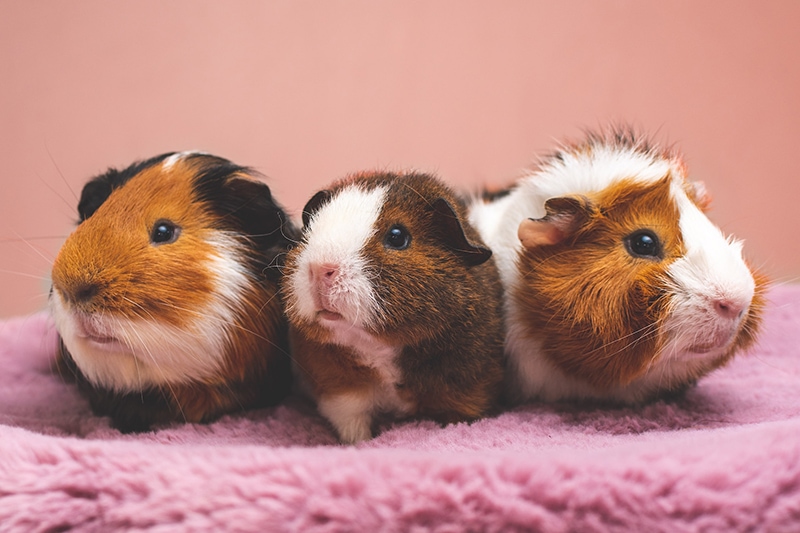
Click to Skip Ahead
When it comes to owning guinea pigs, it’s better to have more than one. Unlike other pets, such as cats and dogs, who are often happy living without a playmate, guinea pigs become depressed reasonably quickly without a friend. For this reason, some countries have introduced laws that prohibit keeping just one guinea pig.
In the wild, guinea pigs herd together and live in large groups. The herding lifestyle keeps your guinea pig healthy, alert, and playful. If guinea pigs are left alone for extended periods, they may develop unwanted or uncharacteristic behaviors such as lethargy, hiding, depression, and sometimes illness.
Although guinea pigs are exceptionally friendly, many people wonder, are guinea pigs territorial? Guinea pig groups always have “leaders,” so yes, they are territorial at first to establish dominance. However, when it comes to pairing or introducing a new guinea pig to your existing guinea pig or group, there are precautions, steps to take, and troubleshooting methods, which you will learn in this article.
Determining Which Guinea Pigs Are Most Compatible
Although guinea pigs should not live in solitary, you must always take precautions before pairing guinea pigs. Without preparation, your guinea companion will become hostile to assert dominance, leading to fights and an unsuccessful pairing.
The most compatible suitors are guineas that have similar personalities, are the same gender, and when one is smaller or younger than the other. Here’s why:
When bonding new guinea pigs, you must ensure their personalities are compatible. For example, you want something other than a feisty guinea paired with a laid-back guinea. Otherwise, an imbalance in dominance control becomes a problem.
- A pair that is already bonded
- Two young guinea pigs of around the same age
- One neutered male coupled with one or more females
- Same-gender cage mates—if they have complementing personalities
If you introduce a new male to an existing male, they may fight for dominance, so ensure that you get a guinea pig who’s easygoing or younger than the other. The same rules apply when introducing a new female. An existing guinea pig takes authority in most cases, so if your new guinea is around the same age or older, prepare to break up many unnecessary fights.
It’s best to aim for a younger guinea pig or two species of the opposite gender. When getting the opposite gender, ensure your male is neutered to avoid unwanted pregnancies. Although, if you intend to breed, make sure you have a clear plan for your baby guineas (whether you intend to keep them or give them to a good home).
The 6 Steps to Take During the Introductory Period
Introducing your new guinea pig to the pack leader is essential to establish a hierarchy immediately. While introducing a new guinea to a group or existing piggie may sound overwhelming and complex, the process will go smoother if you follow our guide.
1. Quarantine
Upon bringing a new guinea home, you’ll want to ensure they have their own environment. Never place a new guinea pig in with the old one right away. The new guinea will need space and time to adjust to their surroundings for at least 2 weeks.
You must bond with your new piggie during the 2 weeks to establish trust. Before the first meeting, you’ll need to prepare a neutral environment. A neutral environment includes a clean and well-prepared area big enough for two (or the group). The neutral space must have hay, water, treats, and hiding places for each guinea.
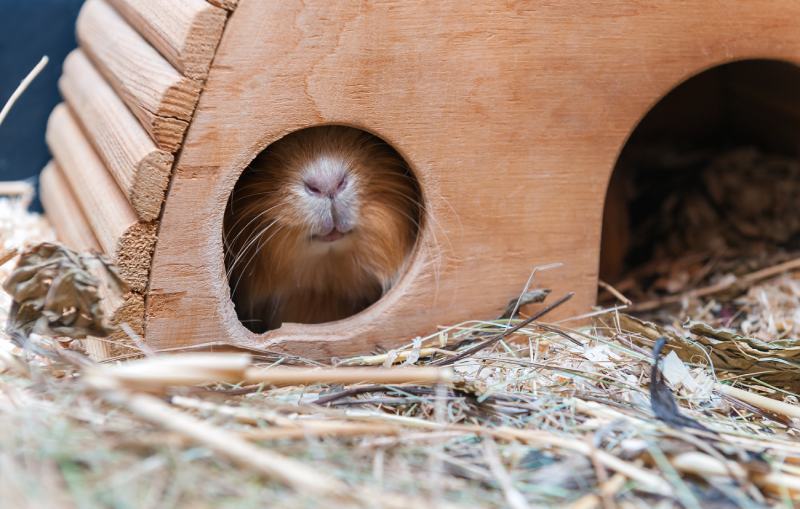
2. Swap Belongings
You can start scent swapping after bringing your new guinea home and having no signs of illness after the quarantine period. Scent swapping is where you move one guinea’s belongings to the other guinea’s cage.
Scent swapping is vital because it allows your guinea pigs to become familiar with each other’s scent. You can also swap guinea pigs’ homes to make scent swapping easier. Keep the old and new guinea from staying in the other’s home for a short time (approximately half an hour at a time) because it may cause one to get stressed, which will delay the introductory process.
3. First Introduction Using Mesh or Clear Wall
It’s time for your guinea pigs to meet! In a clean and neutral environment, place a divider in the middle of the introduction area. Have your old guinea(s) on one side and your new piggie(s) on the other.
It’s normal to witness some squeaking, sniffing, and grunting. Other normal behaviors include:
- Nudging or getting closer
- Teeth-chattering
- Yawning
- Throwing heads back
- Rumble strutting (kicking back legs)
While the above signs may seem negative, guinea pigs typically undergo their own process to maintain dominance and establish a group hierarchy. The behavior will continue until the “leader” enforces control.
However, if you hear excited squeals, the process is a success, and you can take away the barrier and move them closer. Remember that you may not be able to remove the barrier upon the first greeting. Moving them in together can take up to a week or more. It’s also strongly recommended to make sure the first non-barrier introduction is in a neutral location.
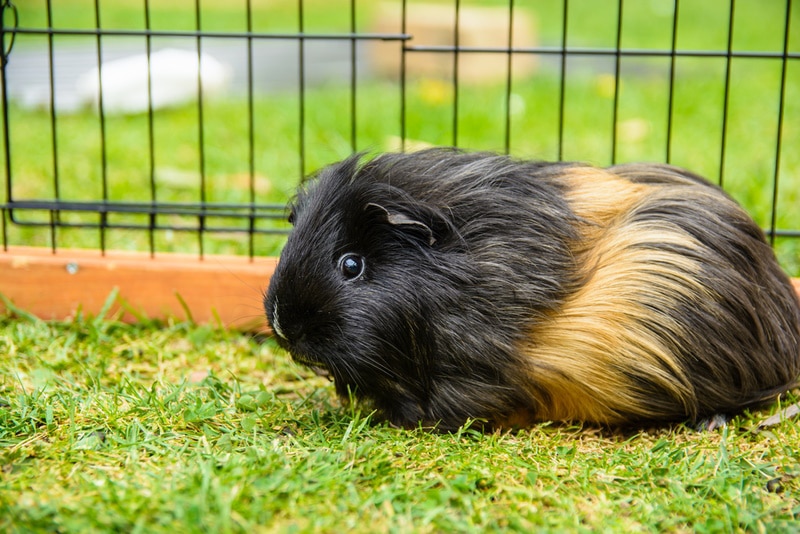
4. Watch for Negative Behavior
During the entire process, you’ll want to closely monitor your guinea pigs’ behaviors. Some interactions may seem hostile and unfriendly, though it’s a process that might take place to establish a harmonic bond. However, some interactions are worth intervening in. Your job is to understand when to intervene.
Guinea pigs need the time and space to enforce leadership among the group. It’s normal to hear teeth-chattering for the first couple of weeks. Nipping creates boundaries, and mounting enforces pack leadership.
Most interactions will seem like you must intervene, but it’s best to leave them to establish their hierarchy. For example, if you witness raised hair and feet stamping, it’s a sure sign they are preparing for a fight. However, one may back down, so do not intervene unless there are signs of serious harm like biting or persistent chasing.
5. Move Them Closer
After showing positive behaviors like popcorning (jumping excitedly) or squealing with excitement, it’s time to take away the divider. You will still need to watch the group in case of severe aggression.
- Grooming
- Sharing food and water
- Laying with each other
- Sniffing each other
- Being exceptionally vocal
- Nipping or biting
- Persistent chasing
- Snorting
- Excessive teeth-chattering
- Hiding or trying to escape
- Opening mouths at each other
- Fighting
As long as the behavior is positive (with some signs of dominance control), you can move to the next step. However, if you notice very hostile interactions without positive behavior, you’ll want to separate your guineas for another day and return to the divided barrier.
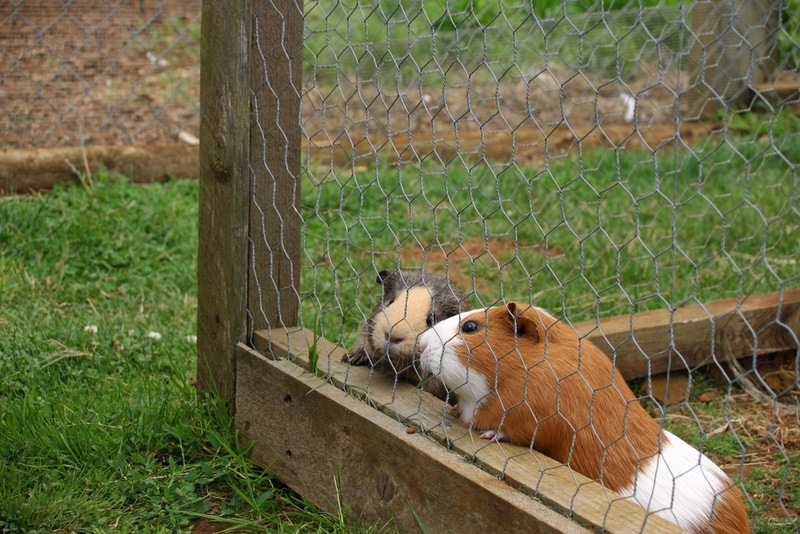
6. Moving In
So, you’ve removed the barrier, the leader has been established, and your guinea pigs are getting along. This is the time when you can combine their habitats. Ensure the habitat has enough space for each guinea pig. There must be the same number of toys and homes as guineas.
Even though your guinea pigs are ready to move in together, they’re still territorial and will get upset or stressed if they don’t have their own area and space. If you’re leaving home for more than 24 hours, it’s best to separate your guinea pigs until you get back so there are no surprises to come home to.
Remember that guinea pigs will fight or enforce boundaries even after living together. You won’t need to supervise as much, but get in tune with hostile behavior because you may need to separate them throughout their lives.
Benefits of a Multi-Piggie Household\
In some jurisdictions, it is illegal to house just one guinea pig.
It’s best to get a pair already bonded when getting guinea pigs for the first time. However, if you only adopted one, you may notice that over time your single guinea pig has become lazy, less vocal, and a bit depressed.
Even if you spend a ton of time with your single guinea pig, it doesn’t make up for those lonely nights or days when you’re out of the house. Each guinea pig needs a friend of their own for the following reasons:

Happier Guinea Pigs
Multi-piggie homes are happier. While you may try to appease your guinea with love and attention, they may still feel lonely and unhappy, wishing they had a companion to cuddle with. Guinea pigs without friends may be more likely to succumb to illness and not enjoy as long a life as other guinea pigs.
Since guinea pigs are prey animals, having a companion makes them feel safe, considering there’s safety in numbers. While you may try your best to make your guinea feel safe and happy, a second piggie is just the fix for your lonely guinea.
Promotes Emotional Bond With the Entire House
Social creatures like guinea pigs form emotional bonds quicker when they have a guinea pig friend. Guinea pigs form bonds the same way that humans do. Think about it; you need family and friends to make you feel well, and so do guinea pigs. Providing your guinea pig with a friend helps them come out of their shell and join the rest of the world because multiple guinea pigs motivate each other.
Less Illness
Guinea pigs are susceptible to many illnesses. When provided with playmates, they’ll eat and exercise more. Your guinea pigs will learn and grow from each other, and the lack of stress from not having a playmate means that your guinea pigs are less likely to experience stress induced illnesses.
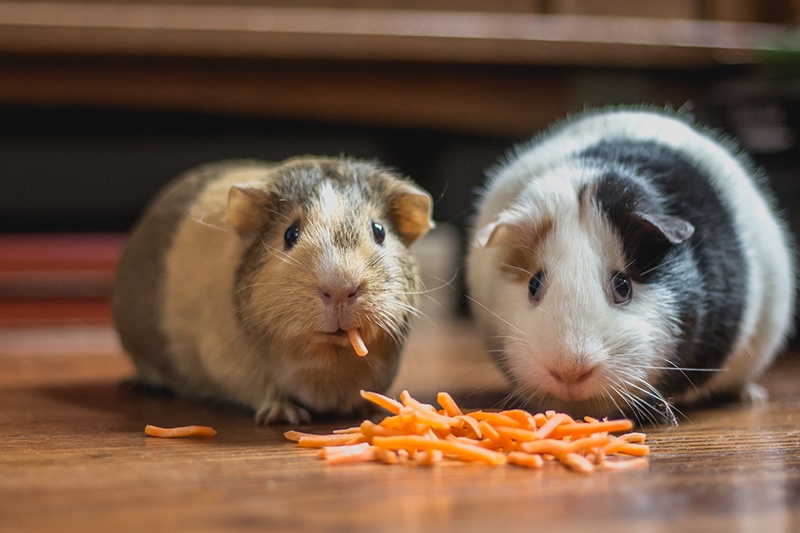
Decreases Depression
A depressed guinea pig will show signs of irritability, aggressive behavior, and lethargy, and they may hide most of the time. The primary cause of depression in guinea pigs is a lack of socialization. Providing a cage mate will prevent and avoid depression in most cases.
However, after getting another guinea pig, if you still notice your guinea friend is depressed, it may be the amount of space in your multi-guinea cage. Ensure each guinea pig has space and interactive toys to prevent depression and boredom.
Troubleshooting Common Issues
Just like humans, guinea pigs can bully and become aggressive towards each other. The main cause is one guinea overstepping their boundaries or getting too close on a bad day. So, keeping a close eye on your guineas daily is a good idea.
Knowing when to intervene is the best and only thing you can do.
- Weight loss
- Skittish behavior from one or all your guineas
- Scabs
- Sores
- Constant teeth-chattering
- Vibrating bodies coupled with feet stamping.
How to Break Up a Fight or Mild Aggression
Upon introduction, leaving your guinea pigs to foot stomp, teeth-chatter, and assert dominance is necessary, as this is the natural way of guinea pigs. However, if you notice these behaviors after a successful pairing and bond is formed, it’s best to immediately take action.
Never separate your guineas with bare hands. Cover one of your guinea pigs with a towel and gently pick them up to move them to a different cage. When separating the guinea pigs, ensure the second cage is nearby so they can still see each other—it’s like separating toddlers for a time-out.
After your guinea pigs calm down, you can reintroduce them. Remember, this may take a few hours or up to a day.

Reintroduction After Separation
Once your guinea pigs are calm enough to be together again, reintroduce them on neutral ground. Ensure the neutral cage has no other scent but is provided with plenty of treats, food, and water. You don’t need to provide a barrier, though placing the guinea pigs in opposite corners is best.
Final Words
It’s best to have multiple guinea pigs for many reasons. Not only does it prevent depression and aggressive behavior, but it is also highly likely that it ensures they attain their maximum lifespan. However, keep going if your guinea pigs are not a good match. Just as you may feel an off vibe from someone you just met, guinea pigs have the same instinct.
The best thing you can do upon introduction is to stay patient and continue trying. Some guinea pigs will match perfectly upon the first greeting; others may take a month or more to get acquainted.
The best chance at success is ensuring you always have a neutral ground for your guinea pigs to return to. You’re sure to have a successful pairing as long as they have enough of their own space, plentiful food, and an unlimited supply of water and toys.
Featured Image Credit: Jaroslaw Slodkiewicz, Unsplash












